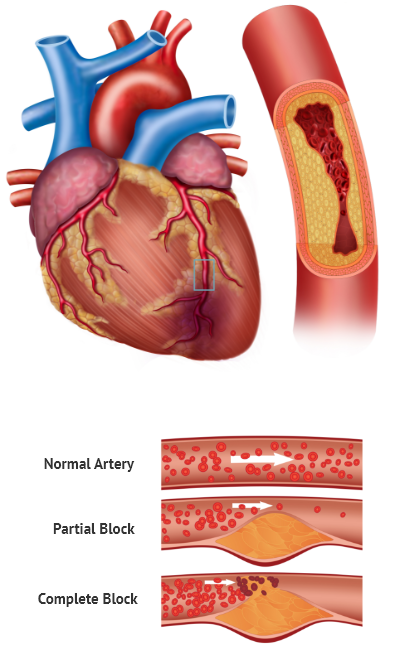Myocardial Infarction (Heart Attack)

Also known as: MI or heart attack
A myocardial infarction occurs when a major vessel that supplies blood to the heart (called the coronary artery) is blocked.
Over the course of time, inflammatory and fatty substances in the body stick to the artery walls forming what is called a plaque (learn about Coronary Artery Disease). When a piece of this plaque is broken off, a clot (called the thrombus) is formed. This can create a blockage in the artery which causes that portion of the heart tissue to be cut off from oxygen. Lack of oxygen to the heart tissue causes damage or death to the affected area.
One may experience different symptoms depending on the amount of blockage (complete or partial). The extent of the damage to the heart determines the severity of the heart attack. If a large portion of the heart is affected this can cause a decrease in the ability of the heart to pump blood out to the rest of the body. This can cause damage to other organs as well due to a lack of blood flow.
Nutshell: Blockage of coronary artery → oxygen & nutrients cannot reach affected portion of the heart → affected tissue is damaged → Heart Attack symptoms
Blockage of the coronary artery due to plaque rupture
- Complete blocks often cause STEMIs (ST-Elevation Myocardial Infarction) or heart attack
- Partial blocks can cause angina (chest pain due to decreased blood flow) or NSTEMIs (Non ST-Elevation Myocardial Infarction), which is another form of a heart attack.

Note: Not everyone may experience all symptoms. Symptoms may vary based on the individual and gender. If you notice any of the symptoms for longer than 5 minutes, please call 911 immediately.
Women – are more likely to have the “uncommon” symptoms along with the classic symptoms. Some might not experience any symptoms at all.
Men – typically experience classic symptoms but may experience less noticeable symptoms. Some might not experience any symptoms at all.
- Stress
- Smoking or the use of other tobacco products
- Sedentary lifestyle
- Eating a diet low in fruits and vegetables
- High LDL (bad cholesterol)
- Low HDL (good cholesterol)
- High blood pressure
Show references
Anderson JL, Morrow DA. Acute Myocardial Infarction. N Engl J Med. 2017;376(21):2053-2064. doi:10.1056/NEJMra1606915
Saleh M, Ambrose JA. Understanding myocardial infarction. F1000Res. 2018;7:F1000 Faculty Rev-1378. Published 2018 Sep 3. doi:10.12688/f1000research.15096.1
Thygesen K, Alpert JS, Jaffe AS, Chaitman BR, Bax JJ, Morrow DA, White HD; Executive Group on behalf of the Joint European Society of Cardiology (ESC)/American College of Cardiology (ACC)/American Heart Association (AHA)/World Heart Federation (WHF) Task Force for the Universal Definition of Myocardial Infarction. Fourth Universal Definition of Myocardial Infarction (2018). J Am Coll Cardiol. 2018 Oct 30;72(18):2231-2264. doi: 10.1016/j.jacc.2018.08.1038. Epub 2018 Aug 25. PMID: 30153967.
Canto JG, Shlipak MG, Rogers WJ, et al. Prevalence, clinical characteristics, and mortality among patients with myocardial infarction presenting without chest pain. JAMA. 2000;283(24):3223-3229. doi:10.1001/jama.283.24.3223
Mythili S, Malathi N. Diagnostic markers of acute myocardial infarction. Biomed Rep. 2015;3(6):743-748. doi:10.3892/br.2015.500
Thygesen K, Mair J, Katus H, et al. Recommendations for the use of cardiac troponin measurement in acute cardiac care. Eur Heart J. 2010;31(18):2197-2204. doi:10.1093/eurheartj/ehq251
Thygesen K, Mair J, Katus H, et al. Recommendations for the use of cardiac troponin measurement in acute cardiac care. Eur Heart J. 2010;31(18):2197-2204. doi:10.1093/eurheartj/ehq251
Hung MJ, Hu P, Hung MY. Coronary artery spasm: review and update. Int J Med Sci. 2014;11(11):1161-1171. Published 2014 Aug 28. doi:10.7150/ijms.9623
Aghdam MRF, Vodovnik A, Sund BS. Sudden death associated with silent myocardial infarction in a 35-year-old man: a case report [published correction appears in J Med Case Rep. 2018 Feb 22;12 (1):52]. J Med Case Rep. 2016;10:46. Published 2016 Feb 29. doi:10.1186/s13256-016-0823-9
https://www.cardiosmart.org/docs/default-source/assets/infographic/women-and-heart-disease.pdf?sfvrsn=d82ddd1b_2
